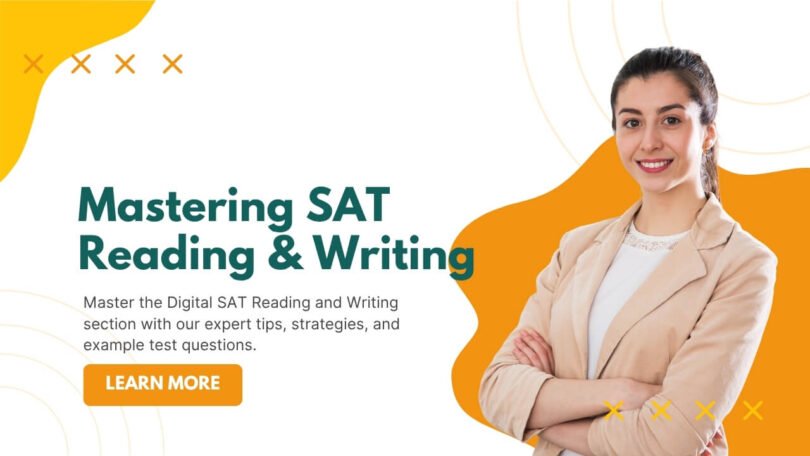Tips & Strategies
The Digital SAT Reading and Writing section combines two skills into one streamlined, fast-paced test. Gone are the days of flipping through pages of long passages. Now, you’ll face a series of short texts, each with a single, targeted question.
Mastering this section is all about understanding the question types and applying the right strategies. This guide will break down the four core skills tested, provide expert tips, and show you sat example tests questions so you can walk in on test day ready to excel.
The Big Picture: What is the Reading & Writing Section?
- Time: 64 minutes (two 32-minute modules)
- Questions: 54 total
- Format: Short passages (from literature, history, science) with one multiple-choice question per passage.
The section tests your skills in four main areas. Let’s dive into each one.
1. Information and Ideas
This is all about comprehension. These questions test whether you can accurately understand what a passage says, both directly and indirectly.
- What it tests: Finding the main idea, locating specific details, understanding charts and graphs, and making logical inferences.
Top Strategy: Stick to the Text
The answer is always directly supported by the information given in the passage. Avoid making assumptions or using outside knowledge. If you can’t point to a specific line or phrase that backs up your answer choice, it’s probably wrong.
SAT example test question:
Passage: The Canary Islands, despite their name, are not named after the bird, but after dogs. The archipelago’s name is derived from the Latin phrase Canariae Insulae, meaning “Islands of the Dogs.” Ancient accounts, notably from Pliny the Elder, describe the islands as being home to large numbers of wild dogs.
Question: According to the text, the name of the Canary Islands comes from…
A) a type of local bird.
B) an ancient Roman elder.
C) the Latin term for dogs.
D) a popular local myth.
Answer: C) the Latin term for dogs.
2. Craft and Structure
This area focuses on how the author makes their point. It’s about analyzing the writer’s choices and their effect on the text.
- What it tests: Understanding a word’s meaning in context, analyzing the purpose of a sentence or phrase, and recognizing the overall structure of a text.
Top Strategy: Define Words in Context
For “Words in Context” questions, don’t just pick the answer with the most common definition. Plug each answer choice back into the sentence to see which one makes the most sense based on the surrounding clues.
SAT example test question:
Passage: The scientist was a proponent of a methodical approach. She believed that to
executean experiment properly, every step must be planned and documented with extreme care.
Question: As used in the text, “execute” most nearly means…
A) terminate.
B) perform.
C) program.
D) approve.
Answer: B) perform.
3. Expression of Ideas
This is where you become the editor. These questions ask you to improve the way ideas are written to make them clearer and more effective.
- What it tests: Using transition words logically and making sentences more precise and concise to meet a specific rhetorical goal.
Top Strategy: Understand the Relationship Between Ideas
For transition questions, ask yourself: “What is the relationship between this sentence and the previous one?” Is it showing a contrast (however), a result (therefore), or an addition (moreover)? Identifying this relationship will lead you to the correct transition word.
SAT example test question:
Sentence: The team practiced for weeks; ________, they were confident they would win the championship.
Question: Which choice completes the text with the most logical transition?
A) however
B) for instance
C) accordingly
D) meanwhile
Answer: C) accordingly
4. Standard English Conventions
This is the grammar section. It’s a direct test of your knowledge of the rules of standard written English.
- What it tests: Punctuation (commas, semicolons, apostrophes), sentence structure (fragments, run-ons), subject-verb agreement, and correct pronoun usage.
Top Strategy: Know Your Comma Rules
Punctuation, especially comma usage, is a huge part of this section. Master the rules for using commas with lists, introductory phrases, and non-essential clauses. Many questions can be answered correctly simply by spotting a comma error.
SAT example test question:
Sentence: The lead actor, along with the supporting cast, ______ ready for the final scene.
Question: Which choice completes the text so that it conforms to the conventions of Standard English?
A) are
B) were
C) is
D) have been
Answer: C) is (The subject is “The lead actor,” which is singular.)
The key to success on the sat reading and Writing section is consistent practice. The more you familiarize yourself with these question types and strategies, the faster and more accurately you’ll be able to work through them on test day.
Ready to put these strategies to the test? Try our free, section-based Digital SAT Reading & Writing Practice Test now!







